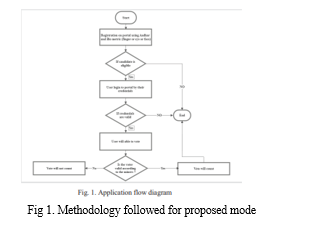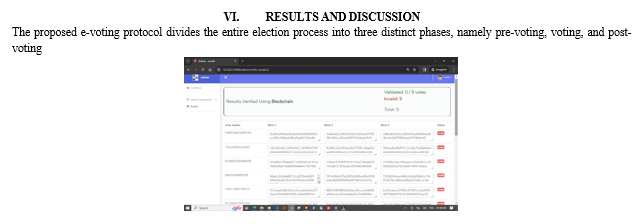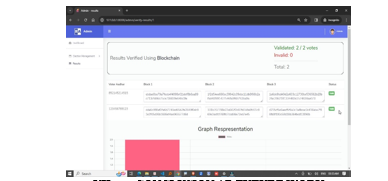Ijraset Journal For Research in Applied Science and Engineering Technology
- Home / Ijraset
- On This Page
- Introduction
- Conclusion
- References
- Copyright
Implementing a Blockchain-based E-Voting System for India: Mitigating Security Challenges through Aadhaar Card Authentication
Authors: Mrs. D. Bhavya Reddy , V S.V.L. Nagamani , Abbireddy Pullaji, Potnuri Sai Suresh , Adabala Dileep Kumar
DOI Link: https://doi.org/10.22214/ijraset.2024.61173
Certificate: View Certificate
Abstract
Introduction
I. INTRODUCTION
Any democratic society must have elections, thus it is crucial to guarantee their integrity and fairness. Technology has significantly improved many facets of social life, and e-voting technologies have emerged as a viable way to improve election security, efficiency, and transparency. Voter impersonation, vote tampering, and hacking are just a few of the security and privacy risks that traditional e-voting systems are vulnerable to. In light of this, blockchain technology has drawn interest as a possible remedy to these problems and offer safe and transparent voting procedures.
Blockchain is a distributed ledger technology that eliminates the need for middlemen by allowing several parties to administer the same database. This technology's decentralization, immutability, and transparency are just a few of the features that make it suitable for voting systems. Furthermore, blockchain technology can be integrated with the Aadhaar card authentication system used in India to create a secure and efficient online voting system. The Aadhaar unique identification system assigns each Indian resident a 12-digit number based on biometric and demographic information. The Aadhaar system has been utilized for a variety of purposes, including financial transactions and identity verification for government services.
The proposed blockchain-based e-voting system addresses the security difficulties with traditional e-voting systems by improving the efficiency, transparency, and security of Indian elections through the use of Aadhaar card authentication for voter identification. Blockchain technology makes the voting process safer, more transparent, and impregnable, while Aadhaar card authentication makes voter identification reliable and effective. This paper provides a theoretical framework for an electronic voting system based on blockchain technology in India, with voter identity using Aadhaar card authentication.
The proposed methodology might serve as a model for other countries looking to use blockchain-based electronic voting systems, and it is expected to increase the efficacy, security, and transparency of elections in India. More research and development are required to improve the proposed protocol's effectiveness and scalability, security against potential threats, and resilience against vulnerabilities. Furthermore, more research is needed to understand voter attitudes and perspectives
II. LITERATURE SURVEY
"An e-voting system based on blockchain technology," -Voting online is becoming more popular due to its convenience and potential cost savings.
Voting online from anywhere with an internet connection eliminates the need for paper ballots and polling site visits. However, some people are concerned about the consequences of voting online. If there is a problem, many votes could be affected. Blockchain technology is being used to improve the security and reliability of online voting. This technology enables voter protection and accuracy. This essay discusses the challenges that remain to be overcome and how blockchain can be used for online voting. Overall, using blockchain for voting could help solve some of the problems we have with elections, but there are still some issues that need to be addressed
"A secure e-voting system using blockchain technology," E-voting, or electronic voting, is one example of modern democratic practices. Electronic voting systems have gained popularity in recent years due to their high ballot privacy and verifiability. All currently in use electronic voting systems have a serious flaw in their design: they are all centralized by default, which implies that a single provider handles the code base, database, and system outputs, as well as providing the monitoring tools required to confirm the result. Because these centralized techniques are unable to create an outcome that can be independently checked, voters may be less likely to participate in elections or have reservations about the results that are released. We intend to use the Blockchain as a secure transaction database to provide an immutable, verifiable, and safe online voting system. When voters independently audit the inclusion of their vote and the election's overall outcome from this public ledger, they may be confident that the results will not be changed due to the immutability of the Blockchain.
"A voting system for developing countries based on blockchain technology" Even if many people do not believe the ballot-paper-based voting method, elections are necessary for democratic governance and play an important part in selecting the best person to lead a country. As a result, many countries around the world are introducing electronic voting. Despite their numerous advantages, electronic voting systems have some downsides, including the possibility of massive vote manipulation due to a single defect. Current e-voting frameworks can be addressed by employing and merging blockchain technology, biometric technology, and other cutting-edge technologies. This study looks at the conditions for modeling voting technology systems, as well as future blockchain and biometric applications. Based on our requirements analysis, we recommend a hyperledger fabric-based, biometric-enabled voting system to automate identity verification while also ensuring the security and transparency of electronic voting. To evaluate the proposed framework, we employ the software architecture analysis approach and active reviews for intermediate designs. The capacity to demonstrate the effectiveness and high-quality elements of architectural design will allow us to use the system in real-world scenarios in future research projects. To demonstrate the framework, we first build a web-based prototype. Our future research goal is to evaluate the prototype in terms of needs and security standards, as well as to implement it on a large scale.
III. SYSTEM ANALYSIS
A. Existing System
The proposed biometric electoral voting system allows the user's credentials to be compared to existing fingerprint and iris scans kept in the system's database. Voting is now faster, safer, and more efficient because counting occurs immediately. This approach requires the voter's thumb impression, iris image, and confirmation of their Aadhaar cards. Each voter's complete information, including iris and fingerprint images, is collected and stored in a database. Voters verify their identity by entering their Aadhaar card information, inserting their finger within a fingerprint scanner, and placing their eye in front of an iris camera. The system verifies the voter's identification by matching the iris image to the existing seal in the database. If the data matches, the voter is instructed to vote electronically. The voter is barred from voting, and vote rigging is suspected if the fingerprints do not match, the voting officer looks for the voter's registration, or the iris image does not match after the fingerprints do.
DISADVANTAGES OF THE EXISTING SYSTEM
- Security and Tampering: Discuss how the current system is vulnerable to electoral fraud and tampering.
Highlight past incidents of suspected electoral fraud or involvement.
Discuss cases in which electronic voting machines (EVMs) have been accessed without authorization and the risk of vote manipulation.
2. Accountability and transparency: Explain how the current voting procedure is opaque in terms of reporting and counting votes.
Discuss the problems in auditing and certifying election results.
Draw attention to instances of doubt and disagreement over the election's transparency.
Voter Identification and Impersonation
B. Proposed System
The security and integrity of Indian elections are key concerns, and the proposed e-voting protocol addresses these. The Aadhaar Card, provided by the Unique Identification Authority of India (UIDAI), is used to ensure each voter's unique identification under the protocol. The election process is divided into three phases: pre-voting, voting, and post-voting, each with its own set of regulations and principles that work together to ensure impartiality and openness. Several protocols must be followed before the actual voting process begins. At this point, the processes require that a central authority (CA) participate in voter registration. The CA's job is limited to voter registration and has no impact on the election's decentralized blockchain framework. Using a system, each voter will be assigned a unique identity that is linked to their Aadhaar Card. During the voting process, this identification is used to verify the voter's eligibility to vote. To register voters, a central authority (CA) must be involved at the pre-voting stage. The CA will assign each voter a unique identity number that is linked to the information on their Aadhaar card. This ensures that every voter is eligible to participate in the actual voting process.
IV. SYSTEM DESIGN
A. System Architecture
The below diagram depicts the whole system architecture.

V. SYSTEM IMPLEMENTATION
MODULES
- Blockchain Infrastructure:
This section explains how the electronic voting mechanism was constructed. It includes of the blockchain network configuration, the consensus mechanism, and smart contracts for voting records and vote verification.
Functions: Maintains transparency, decentralization, and data immutability during the voting process.
2. Aadhaar Card Authentication Module:
Purpose: In charge of validating voters' identities using their Aadhar cards.
Functions: Increases voting process security and prevents voter impersonation.
3. Voter registration and identification:
Verification: Overview: Oversees the registration and identification of eligible voters.
Functions: Maintains data integrity and confirms the voter list's accuracy.
4. Vote Casting and Encryption:
Overview: Uses blockchain technology to safeguard the voting process.
Functions: To protect voter privacy, ballot choices are encrypted.
5. Vote Counting and Verification:
Purpose: Responsible for the transparent counting and verification of votes.
Functions include independent verification of results and ensuring the correctness of the vote-counting system.
6. Security measures:
Described as follows: Implements security protocols in each module to protect against manipulation and hacking.
Functions: Encrypts data, uses multi-factor authentication, and other security measures to protect the system from assaults.
7. Scalability and Performance Optimization:
Overview: Addresses scalability difficulties in support of large-scale election operations.
Features: Improves system performance to handle a huge number of votes.
8. User interface and accessibility:
Describes: Provides voters with an easy-to-use interface while ensuring accessibility for a diverse range of users, including distant voters and those with special needs.
Features: Encourages diversity and enhances the overall voting experience.
9. Integration with Current Election Infrastructure:
This section explains how to work with electoral commissions and administrative processes to guarantee a smooth and quick transition to India's existing election infrastructure.
Features: Makes it easier to transition from the existing system to blockchain-based electronic voting.
10. Logging and Audit Trail: This feature retains detailed records of every vote and transaction conducted on the blockchain.


Conclusion
Traditional Indian e-voting systems\' security problems are imaginatively addressed by the proposed blockchain-based e-voting system with Aadhaar card identification. The use of blockchain technology ensures that the voting process is transparent and irreversible, and the eligibility of voters is validated by Aadhaar card validation, which provides a unique identifying mechanism. The suggested e-voting protocol divides the entire election process into three distinct phases: pre-voting, voting, and post-voting. At each level, a series of norms and procedures are followed to ensure that the electoral process is secure, fair, and transparent. The protocol does not change the decentralized nature of the blockchain-based election; rather, it leverages the central authority just for voter registration. Overall, the proposed blockchain-based e-voting system with Aadhaar card identification can address the security challenges associated with traditional e-voting systems, hence boosting the effectiveness, openness, and security of Indian elections. It is hoped that this study would contribute to the ongoing discussions in India and other countries about the development of transparent and secure voting systems.
References
[1] J. Kinoshita, M. Sakuma, and T. Kasahara, \"An e-voting system based on blockchain technology,\" in Proc. 12th International Conference on Computer Science and Education, 2017, pp. 28-32. [2] S. Bhattacharya, A. Sengupta, and A. Mukherjee, \"A secure e-voting system using blockchain technology,\" in Proc. International Conference on Advances in Computing, Communications and Informatics, 2016, pp. 582-587. [3] M. Shahzad, A. Awais, and N. Khan, \"A blockchainbased e-voting system for developing countries,\" in Proc. International Conference on Frontiers of Information Technology, 2018, pp. 284-289. [4] N. Kshetri, S. Voas, and R. Paciello, \"Blockchainenabled e-voting system for small and medium-sized enterprises,\" Journal of Enterprise Information Management, vol. 33, no. 5, pp. 776-794, 2020. [5] S. Bose, D. Bhattacharyya, and D. Roychowdhury, \"Design of a secure and robust e-voting system for Indian elections,\" International Journal of Network Security, vol. 22, no. 5, pp. 891-900, 2020. [6] P. Jain and P. Jain, \"A blockchain-based e-voting system for India,\" in Proc. International Conference on Computing, Communication and Automation, 2018, pp. 1046-1051. [7] A. A. Monrat, O. Schelén, and K. Andersson, ‘‘A survey of blockchain from the perspectives of applications, challenges, and opportunities, ’’IEEE Access, vol. 7, pp. 117134–117151, 2019. [8] O. Cetinkaya and D. Cetinkaya, “Verification and Validation issues in electronic voting,” Electronic Journal of E-Government, vol. 5, no. 2, pp. 117-126, 2007 [9] S. Bhatia, S. Mittal, and S. Bansal, \"Blockchain-based secure and decentralized voter registration and voting system,\" Journal of Network and Computer Applications, vol. 127, pp. 38-55, 2019. [10] R. Gupta, A. Singh, and R. Kumar, \"A blockchainbased decentralized e-voting system using cryptographic techniques,\" International Journal of Engineering and Advanced Technology (IJEAT), vol. 9, no. 5, pp. 10614- 10618, 2020. [11] M. A. Islam and A. Y. H. Abdullah, \"A blockchainbased e-voting system using homomorphic encryption for verifiability, privacy, and fairness,\" Future Generation Computer Systems, vol. 113, pp. 548-558, 2021. [12] T. Wang, L. Zhou, and Y. Wang, \"Design and implementation of a blockchain-based e-voting system with smart contracts,\" Security and Communication Networks, vol. 2020, Article ID 8877583, 2020. [13] S. Dey, R. Pal, and D. Jana, \"A blockchain-based evoting system with voter privacy preservation,\" in Proc. International Conference on Computing, Communication and Intelligent Systems, 2021, pp. 148-153.
Copyright
Copyright © 2024 Mrs. D. Bhavya Reddy , V S.V.L. Nagamani , Abbireddy Pullaji, Potnuri Sai Suresh , Adabala Dileep Kumar. This is an open access article distributed under the Creative Commons Attribution License, which permits unrestricted use, distribution, and reproduction in any medium, provided the original work is properly cited.

Download Paper
Paper Id : IJRASET61173
Publish Date : 2024-04-28
ISSN : 2321-9653
Publisher Name : IJRASET
DOI Link : Click Here
 Submit Paper Online
Submit Paper Online

